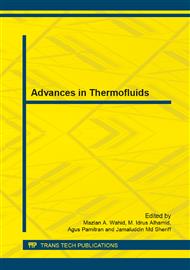[1]
M. Katsuki and T. Hasegawa, The science and technology of combustion in highly preheated air, 1998, pp.3135-3146.
DOI: 10.1016/s0082-0784(98)80176-8
Google Scholar
[2]
A. Cavaliere and M. de Joannon, Mild combustion, Progress in Energy and Combustion Science, vol. 30, pp.329-366, (2004).
DOI: 10.1016/j.pecs.2004.02.003
Google Scholar
[3]
J. A. Wunning and J. G. Wunning, Flameless oxidation to reduce thermal NO-formation, Progress in Energy and Combustion Science, vol. 23, pp.81-94, (1997).
DOI: 10.1016/s0360-1285(97)00006-3
Google Scholar
[4]
A. K. Gupta, Effect of air preheat temperature and oxygen concentration on flame structure and emission, Journal of Energy Resources Technology-Transactions of the Asme, vol. 121, pp.209-216, Sep (1999).
DOI: 10.1115/1.2795984
Google Scholar
[5]
X. Xing, Structure of reaction zone of normal temperature air flameless combustion in a 2 ton/h coal-fired boiler furnace, Proceedings of the Institution of Mechanical Engineers Part a-Journal of Power and Energy, vol. 221, pp.473-480, Jun (2007).
DOI: 10.1243/09576509jpe308
Google Scholar
[6]
B. Cain, The Development and Application of Direct Fuel Injection Techniques for Emissions reduction in High Temperature Furnaces, (2000).
Google Scholar
[7]
I. Nakamachi, Apparatus or method for carrying out combustion in a furnace, ed: Google Patents, (1990).
Google Scholar
[8]
A. Sobiesiak, Performance Characteristics of the Novel LowNOx CGRI Burner For Use with High Air Preheat, Combustion and flame, vol. 115, pp.93-125, (1998).
DOI: 10.1016/s0010-2180(97)00366-0
Google Scholar
[9]
A. K. Gupta, Thermal characteristics of gaseous fuel flames using high temperature air, Journal of Engineering for Gas Turbines and Power-Transactions of the ASME, vol. 126, pp.9-19, Jan (2004).
DOI: 10.1115/1.1610009
Google Scholar
[10]
A. K. Gupta, Flame characteristics and challenges with high temperature air combustion, 2000, pp.1-18.
Google Scholar
[11]
S. E. Hosseini, Wahid, M.A., Abuelnuor, A.A.A., High temperature air combustion: Sustainable technology to low NOx formation, International Review of Mechanical Engineering, vol. Volume 6, pp.947-953, July 2012 (2012).
Google Scholar
[12]
N. Rafidi, et al., High-Temperature Air Combustion Phenomena and Its Thermodynamics, Journal of Engineering for Gas Turbines and Power, vol. 130, p.023001, (2008).
DOI: 10.1115/1.2795757
Google Scholar
[13]
H. Tsuji, High temperature air combustion: from energy conservation to pollution reduction vol. 4: CRC, (2003).
Google Scholar
[14]
B. B. Dally, et al., Effect of fuel mixture on moderate and intense low oxygen dilution combustion, Combustion and Flame, vol. 137, pp.418-431, Jun (2004).
DOI: 10.1016/j.combustflame.2004.02.011
Google Scholar
[15]
C. T. Bowman, Control of combustion-generated nitrogen oxide emissions: technology driven by regulation, 1992, pp.859-878.
DOI: 10.1016/s0082-0784(06)80104-9
Google Scholar
[16]
W. Yang and W. Blasiak, Effects of fuel temperature and flame locations on emissions of nitrogen oxides in combustion with high temperature air, 2003, pp.18-21.
Google Scholar
[17]
N. Krishnamurthy, et al., Studies on low-intensity oxy-fuel burner, Proceedings of the Combustion Institute, vol. 32, pp.3139-3146, (2009).
DOI: 10.1016/j.proci.2008.08.011
Google Scholar
[18]
N. Rafidi, Thermodynamic aspects and heat transfer characteristics of HiTAC furnaces with regenerators, KTH, (2005).
Google Scholar
[19]
Z. Cao, et al., Thermal and emission characteristics of high temperature air combustion: A technical review, 2010, pp.4010-4014.
Google Scholar
[20]
W. H. Yang, et al., Influences of flame configurations on flame properties and NO emissions in combustion with high-temperature air, Scandinavian Journal of Metallurgy, vol. 34, pp.7-15, Feb (2005).
DOI: 10.1111/j.1600-0692.2005.00710.x
Google Scholar
[21]
W. Yang, Experimentaland Mathematical Modeling Study Underthe High Temperatureand Oxygen Deficient Oxidzers, PhD, Politechnika Gdanska Wydzial Mechnniczny Katedra Techniki Cieplnej Gdańsk , Poland (2008).
Google Scholar
[22]
E. Cho, et al., Characteristics of Multi-Burner Positioning and Operating Mode in a FLOX TM Furnace.
Google Scholar
[23]
B. Danon, et al., Emission Measurements in a Multi-Burner FLOX® Furnace, in Proceedings of the 4th European Combustion Meeting, 2009, pp.1-6.
Google Scholar
[24]
B. Danon, et al., Emission and Efficiency Comparison of Different Firing Modes in a Furnace with Four Hitac Burners, Combustion Science and Technology, vol. 183, pp.686-703, (2011).
DOI: 10.1080/00102202.2011.553643
Google Scholar
[25]
B. Danon, et al., Parametric optimization study of a multi-burner flameless combustion furnace, Applied Thermal Engineering, vol. 31, pp.3000-3008, (2011).
DOI: 10.1016/j.applthermaleng.2011.05.033
Google Scholar
[26]
B. Danon, Furnaces with multiple flameless combustion burners, PhD Dissertation, Energy Technology, Delft University of Technology, (2011).
Google Scholar
[27]
E. S. Cho, et al., Behavior of a 300 kWth regenerative multi-burner flameless oxidation furnace, Applied Energy, vol. 88, pp.4952-4959, (2011).
DOI: 10.1016/j.apenergy.2011.06.039
Google Scholar
[28]
Seyed Ehsan Hosseini, Mazlan A. Wahid, Feasibility study of biogas production and utilization as a source of renewable energy in Malaysia, Renewable and Sustainable Energy Reviews, 19 (2013) 454–462.
DOI: 10.1016/j.rser.2012.11.008
Google Scholar
[29]
Seyed Ehsan Hosseini, Mazlan A. Wahid, Necessity of biodiesel utilization as a source of renewable energy in Malaysia, Renewable and Sustainable Energy Reviews, 16(8): 5732-5740.
DOI: 10.1016/j.rser.2012.05.025
Google Scholar
[30]
S. E Hosseini, S Salehirad, Mazlan A. Wahid, M. M Sies, A. Saat, Effect of diluted and preheated oxidizer on emission of methane flameless combustion, AIP Conference Proceedings 2012, vol. 1440, pp.1309-1312.
DOI: 10.1063/1.4704352
Google Scholar
[31]
Abuelnuor, A.A.A., Mazlan A. Wahid, Aminuddin Saat, M .O. Abdalla, Seyed E. Hosseini, Pollutant reduction and energy saving in industrial sectors by applying high temperature air combustion method, 2012, International Journal on Heat and Mass Transfer – Theory and Applications, Vol 1, N. 1, February 2013, p.121.
Google Scholar


